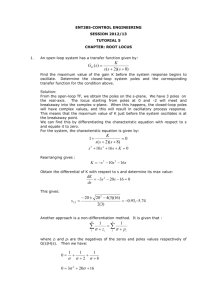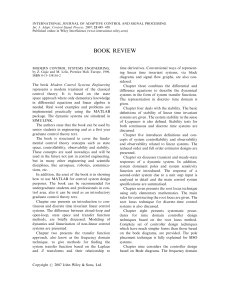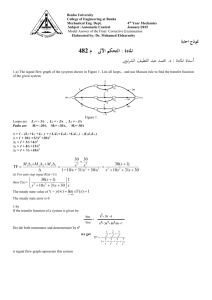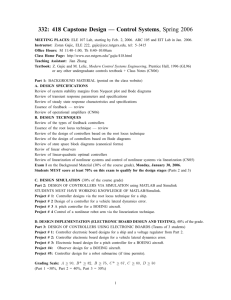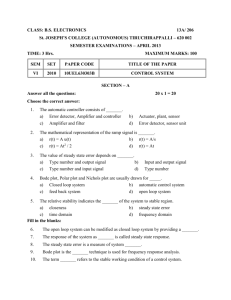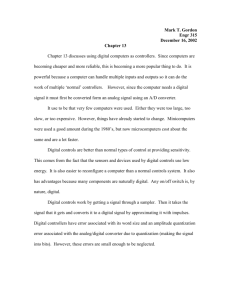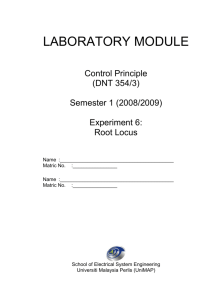Lecture #10
advertisement
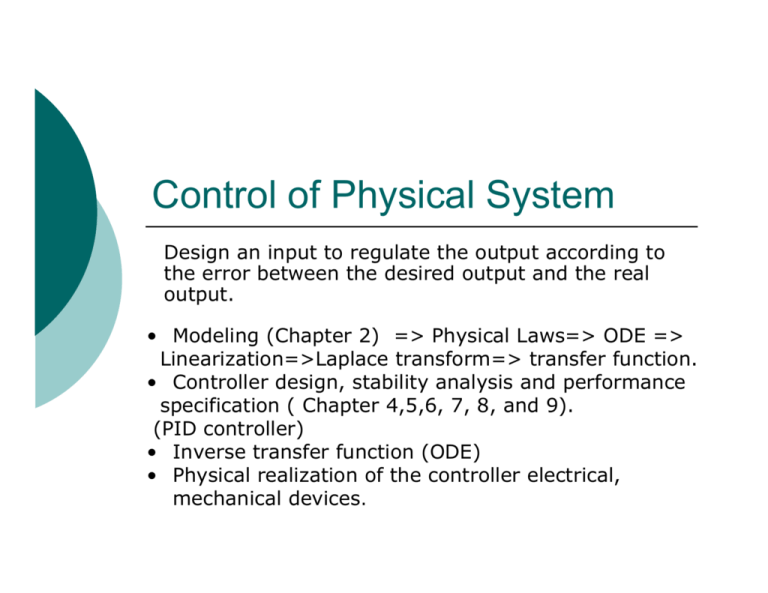
Control of Physical System
Design an input to regulate the output according to
the error between the desired output and the real
output.
• Modeling (Chapter 2) => Physical Laws=> ODE =>
Linearization=>Laplace transform=> transfer function.
• Controller design, stability analysis and performance
specification ( Chapter 4,5,6, 7, 8, and 9).
(PID controller)
• Inverse transfer function (ODE)
• Physical realization of the controller electrical,
mechanical devices.
Classical control vs Modern control
Classical control:<both time domain and frequency domain>
Linear-time-in-varying system
Dealing with single input and single output (SISO) system.
Control approaches: analogy or digital
Modern control:
state equation representation (time domain) Multiple inputs
and Multiple outputs (MIMO): linear-time-in-varying system.
Nonlinear system control: time-domain,
Adaptive control, robust control, fuzzy logical control, neural
network control, ect
Chapter 6
Reading materials: pp. 290-304, 307-309, 316-320.
Concept of stability (absolute and relative), RouthHurwtiz stability criterion, Rough array, four different
cases,
using Rough-Hurwtize criterion to do design and
analysis, select stabile region for given parameters.
S-Plane
and Transient Response
Definitions of Stability
• BIBO stability: A system is said to be BIBO
stable if for any bounded input, its output
is also bounded.
• Absolute stability: Stable /Unstable
• Relative stability: Degree of stability (i.e.
how far from instability)
• A stable linear system described by a T.F.
is such that all its poles have negative
real parts
Relationship between the coefficients
and roots of the characteristic equation
Consider the simple second-order characteristic equation:
Roots:
For a stable system, the roots of the characteristic equation must
have negative real parts.
b/a>0 and c/a>0
What is the requirements for the coefficients?
Is it possible to find the similar conditions for higher order system?
Routh-Hurwitz Criterion
• Consider the polynomial
• Routh-Hurwitz stability criterion is a test to
ascertain without computing the roots, whether
or not all roots of a polynomial have negative
real parts.
• It will be given here without proof
Routh-Hurwitz Table
Δ(s) = q(s) = an s n + an−1s n−1 + ... + a1s + a0 = 0.
The number of roots of Q(s) with positive real parts is
equal to the number of sign changes in the first column
Routh-Hurwitz Criterion
Routh-Hurwitz Criterion
• This criterion requires that there be no changes in sign in
the first column for a stable system. This requirement is
both necessary and sufficient.
• Four distinct cases or configurations of the first column array
much be considered, and each must be treated separately
and requires suitable modifications of the array calculation
procedure:
1. No element in the first column is zero;
2. there is zero in the first column, but some other
element of the row containing the zero in the first
column are nonzero;
3. there is a zero in the first column, and other
elements of the row containing the zero are also
zero;
4. and as in (3) with repeated roots on the jω-axis.
Tracked Vehicle Turning Control
Want
ess to ramp command to be less than 24%
Tracked Vehicle Turning Control
Stability:
Static error to ramp input:
A zero-entry appears in the first column, but
other entries on the row are non-zero
-Solution: Take entry as small value ε >0 and proceed,
taking ε >0 in subsequent calculations. After completing
The process let ε approach to zero.
q( s) = s 5 + 2s 4 + 2s 3 + 4s 2 + 11s + 10.
s 5 1 2 11
s 4 2 4 10
s3 ε 6 0
s 2 c1 10 0
s1 d1 0 0
s 0 10 0 0
4ε −12 −12
6c − 10ε
c1 =
=
, d1 = 1
→ 6.
ε
ε
c1
The system is unstable, and two
roots lie in the right half of the
s-plane.
A zero-entry appears in the first column, and
all other entries in that row are also zero
-Solution: Return to the previous row and form the
“Auxiliary Polynomial, qa(s)”, which will be a divisor
of the original q(s), divide out qa(s), and proceed.
The auxiliary polynomial is the polynomial immediately
precedes the zero entry in Routh array. The order of the
auxiliary polynomial is always even and indicates the
number of symmetrical roots pair.
Example:
1/ 2s +1
q( s ) = s 3 + 2 s 2 + 4 s + K ,
1
2
−
K
8
s1
2
s0 K
3
s
s2
0 < K < 8.
4
K
0
0
k =8⇒
s3 1 4
s2 2 K
s1 0 0
s0 K 0
qa (s)
When K=8
q ( s ) / q a ( s ) ⇒ 2s2 + 8 s3 + 2s2 + 4s + 8
s3
+ 4s
+8
2s2
2
− 2s
+8
=0
Marginal stable
qa (s) = 2s2 + Ks0 = 2s2 +8 = 2(s2 + 4) = 2(s + j2)(s − j2).
q( s) = qa ( s)(1 / 2s + 1) = ( s + 2)(s + j 2)(s − j 2)
( when K = 8)
Repeated roots of the characteristic
equation on the jω-axis
• If the jω-axis roots of the characteristic equation are simple
(first order), the system is neither stable nor unstable; it is
instead called marginal stable, since it has an un-damped
sinusoidal mode.
-If the jω-axis roots are repeated, the system response will be
unstable, with a form t[sin(ωt+Φ)].
-The Routh-Hurwitz criterion will not reveal this form of
instability.
q(s) = (s +1)(s + j)(s − j)(s + j)s − j)= s 5 + s 4 + 2 s 3 + 2 s 2 + s + 1 .
s 5
1 2 1
s 4
1 2 1
s 3 ε ε 0
s 2 1 1
s1
ε 0
s 0
1
s4 + 2s2 +1= (s2 +1)2
⇒ ( s 2 + 1)
Note that the absence of
sign changes, a condition
that falsely indicates that
the system is marginally
stable.
The real response of the system is increase with
time as t[sin(ωt+Φ)] due to the repeated roots.
Example Stabilty region for unstable plant
A jump-jet aircaft has a control system as shown in the Fig.
Goal: Assuming that z>0 and p>0,find a suitable set of K, z,
and p to stabilize the system .
The system is open-loop unstable (without feedback control)
since the characteristic equation of the plant and controller is
Note that since one term within the bracket has a negative
coefficient, the characteristic equation has at least one root
in the right-hand side of the s-plane.
Example Stabilty region for unstable plant
The characteristic equation of the closed-loop is
The goal is to determine the region of stability for K,p,and z.
The Routh array is
where
Example Stability region for unstable
plant
We require that b2 > 0, ( p − 1) > 0, and Kz>0.
b2 =
( p −1)(K − p) − Kz
>0
( p −1)
( p −1)(K − p) − Kz > 0
⇔ ( p −1)(K − p) − Kz > 0
⇔ K [( p − 1) − z ] − p ( p − 1) > 0
p( p −1)
⎧
K
<
if z > ( p −1)
⎪
( p −1) − z
⎪⎪
K [( p − 1) − z ] − p( p − 1) > 0 ⇒ ⇒ ⎨ − p( p −1) > 0 if
z = p −1
⎪
⎧< 0 ?
p( p −1)
⎪
⎪K >
( p − 1) − z = ⎨ = 0 ?
if z < ( p −1)
⎪> 0 ?
( p −1) − z
⎪⎩
⎩
Consider two cases:
1. z ≥ ( p − 1)
There is no 0 < k < ∞ that leads to stability
p ( p − 1)
, with p > 1 and
( p − 1) − z
z < ( p − 1) will result in stability.
2. z < ( p − 1) : Any K >
Example Stability region for unstable plant
The three-dimensional plot of the stability region for K, p, and
z is shown in the following figure.
z ≥ ( p − 1)
Unstable region.
One acceptable point is z=1, p=10, and K=15
Summary
• Routh Hurwitz stability criterion allows
to check for stability without computing
roots of characteristic equation
• Can be used to determine the range of
parameters that guarantees stability
Chapter 7
Reading materials: pp. 331-350, 366-373, pp. 379-383 and
p. 405
Understand the basic concepts of root locus method,
and how to use it for design and analysis. PID controller.
Root Locus Method
• Developed by Evans while
he was a graduate student
at UCLA
• Uses the poles and zeros
of the open-loop system to
determine the closed-loop
poles when ONE parameter
is changing
Walter R. Evans, 1920-1999
Root Locus Concept
T =
KG ( s )
1 + KG ( s )
(Closed-loop Transfer function)
characteristic equation:
1+KG(s)=0
KG(s)=-1
=>
=>
π
-1
KG(s)
Vector or scale equation?
KG(s)=-1+j0
KG(s) ∠KG(s) = e− jπ
(Cartesian form)
(Polar form)
1
KG ( s ) = 1
∠KG(s) = ±k 3600 + π
The values of s that fulfill the angel and magnitude conditions are
The roots of the characteristic equation or the closed-loop poles.
Root Locus Concept
T =
characteristic equation:
KG ( s )
1 + KG ( s )
1+KG(s)=0
The root locus is the path of the roots of the characteristic
equation traced out in the s-plane as a system parameter
(K) is changed. (0<k<∞).
Geometric Interpretation
If
G(s) has been factored into the pole-zero form,
then the magnitude and phase of some G(s*) may be found
by drawing vectors from the singularities to the point s*:
Geometric Interpretation
*
∠G(s* ) = φ1 −θ1 −θ2 −θ3 −θ4
The 7 Steps to the Root Locus
Step 1:
The 7 Steps to the Root Locus
Step 2:
Locus lie to the left of an odd number of poles and
zeros.
Step 3:
The 7 Steps to the Root Locus
Step 4:
Step 5:
Step 6:
The 7 Steps to the Root Locus
Step 7:
7a)
7b)
Breakaway Points
• Obtaining the breakaway points
Rewriting the characteristic equation to isolate :
The breakaway point occur when
Example:
Breakaway Points
Angle departure and arrival
consider the third-order open-loop transfer function
K
.
2
2
( s + p 3 )( s + 2ζω n s + ω n )
q = 1,2,....
F ( s) = G( s) H ( s) =
∠p ( s ) = 1800 ± q3600 ,
The angles at a test point s1 ,
an infinitesimal distance from,
must meet the angle criterion.
Phase criterion
0
Therefore since θ 2 = 90, we have
θ1 + θ 2 + θ 3 = θ1 + 90 0 + θ 3 = +180 0 ,
√
or the angle of departure at pole p1 is
θ1 = 90 0 − θ 3 ,
√
Fourth-Order System
?
?
?
Fourth-Order System
n=4 and m= 0 implies that there are 4 infinite zeros.
N=4 implies that there are 4 separate loci
Fourth-Order System
Asymptotes:
Angles:
Centroid:
np
σ=
nz
∑ p −∑z
j =1
j
i =1
n p − nz
i
Fourth-Order System
Intersection with imaginary axis
=0
Fourth-Order System
Breakaway point:
s ≈ -1.6
Fourth-Order System
Angle of departure:
Angle of departure at pole
Because
Fourth-Order System
ζ=0.707
Fourth-Order System
Root locus examples
GH(s) =
s +1
s2 + 3s +1
1
0.8
0.6
0.4
Apply Steps 1-3
Imag Axis
0.2
0
-0.2
-0.4
-0.6
-0.8
-1
-4
-3
-2
-1
Real Axis
0
1
2
Root locus examples
s +1
GH(s) = 2
s + 3s + 3
1
0.8
0.6
0.4
0.2
Imag Axis
Apply steps 1-4 and
step 5 for breakaway
point
0
-0.2
-0.4
-0.6
-0.8
-1
-3
-2.5
-2
-1.5
-1
Real Axis
-0.5
0
0.5
1
Root locus examples
s −1
GH(s) = 2
s + 3s + 3
1
0.8
0.6
0.4
Step 4 for crossing and
0.2
Step 5 for breakaway point
…
Imag Axis
Apply steps 1-4,
0
-0.2
-0.4
-0.6
-0.8
-1
-3
-2.5
-2
-1.5
-1
-0.5
Real Axis
0
0.5
1
1.5
2
Root locus examples
s2 − s +1
GH ( s ) = 2
s + 3s + 3
1.5
1
0.5
step 4 for crossing
points
Imag Axis
Apply steps 1-3 and
0
-0.5
…
-1
-1.5
-2
-1.5
-1
-0.5
Real Axis
0
0.5
1
Root locus examples
2.5
GH(s) =
1
(s2 +3s +3)(s +2)
2
1.5
1
0.5
Imag Axis
Apply steps 1-4 and 6 :
0
-0.5
-1
-1.5
-2
-2.5
-3
-2.5
-2
-1.5
-1
-0.5
Real Axis
0
0.5
1
1.5
2
Root locus examples
GH(s) =
s −1
(s2 + 3s + 3)(s + 2)
8
6
4
2
Imag Axis
Apply steps 1-4, 6 and
determine the crossing
point by Ruth-Hurwitz
0
-2
-4
-6
-8
-3
-2.5
-2
-1.5
-1
-0.5
Real Axis
0
0.5
1
1.5
2
PID Controller
• “Textbook”
PID controller:
which corresponds to
• In practice:
PID Controller
• PI controller: Used extensively in process
control on a broad range of applications due
to simplicity and relatively good performance
PI controller:
• PD controller: Used extensively in controlling
electromechanical systems
PD controller:
PID Controller
Consider the PID controller
The PID controller introduces a pole at the origin
and two zeros
PID Controller
Using a PID:
Z2
Z* 2
Design of a robot control system
• To achieve the rapid and accurate control a robot, it is is
important to keep arm stiff and yet lightweight.
• The specification for controlling the motion of a lightweight,
flexible arm are
1) a setting time < 2 second
2) a percent overshoot <10% for a step
3) a steady-state error of zero for a step
Design of a robot control system
The transfer function
of the flexible arm
Complex zeros:
Complex poles:
Design of a robot control system
First we consider K2=0,
Complex zeros:
Real poles: s=0; s=-10
Complex poles:
Root locus on real axis?
How the root locus look like?
double
poles
?
?
Design of a robot control system
First we consider K2=0,
Complex zeros:
Real poles: s=0; s=-10
Complex poles:
Is this system stable for K1>0?
The system is unstable since two
roots of closed system appear in
the right-hand s-plane for K1>0.
double
poles
Design of a robot control system
It is clear that we need to
introduce the use of velocity
feedback K2>0. Then we
have
and
We select
in order
to the adjustable zero near
the origin for canceling the
affect of the poles.
The system has 5 zeros and
7 poles.
Design of a robot control system
Root locus on real axis
The system has 5
zeros and 7 poles.
?
Using steps 3-4
to check.
?
?
?
Since the system
has two net
Poles, it must be
stable for all
0<k1<∞
Double poles
Departure
angle
Design of a robot control system
• When K1=0.8 and K2=5, we obtain a step response
with a percent overshoot of 12% and a settling time of
1.8 seconds. This is the optimum achievable response.
• If we use the following controller:
With z=1 and p=5,K2=5, when K1=5 we obtain a step
response with an overshoot of 8% and a settling time of
1.6 seconds.
The specification for controlling the motion of
a lightweight, flexible arm are
1. a setting time < 2 second
2. a percent overshoot <10% for a step
3. a steady-state error of zero for a step
Type two
System
ess=?
Chapter 8
Reading materials: pp. 406-422, pp. 424-430,
pp. 432-439 and pp. 444-450.
Understand the frequency response method,
polar plot, Bode diagram and how to draw the
Bode plot (forward and inverse problem), and
using it to design and analysis system
performance (both transient and steady-state).
Frequency Response Methods
• The sinusoid is a unique input signal, and the
resulting output signal for a linear system as
well as signals throughout the system, is
sinusoidal in the steady state (the out of the
system); it is differs from the input waveform
only in amplitude and phase angle.
• The important issue in frequency response methods is
how to descript the amplitude and phase angle of the
system. We will study different methods to represent
amplitude and phase.
Frequency Response
Consider the system
where pi are assumed
to be distinct poles.
Then in partial fraction form we have
Taking the inverse Laplace transform yields
−1
l
where α and β are constants which are problem dependent.
Frequency Response
If the system is stable, then all pi are have positive nonzero
real parts, (poles are − pi), and
l−1
since each exponential term
decays to zero as t → ∞.
l−1
• Thus the steady-state output signal depends only on the
magnitude and phase of T(jω) at a specific frequency ω.
• Notice that the steady state response as described the
above is true only for stable systems, T(s).
Frequency Response Plots
| G ( ω ) |=
φ = tan
−1
Re 2 ( ω ) + Im 2 ( ω )
Im( ω )
Re( ω )
(Review Appendix G in textbook)
Bode plot analysis techniques
m
Factorization
K
G ( jω ) =
∏ (1 + jω T
zi
)
i =1
n− y−2 w
( jω ) y
∏
w
(1 + j ω T pj )
j =1
∏
k =1
⎛
2ζ k
( jω ) 2
⎜⎜ 1 +
jω +
ω nk
ω nk2
⎝
⎞
⎟⎟
⎠
e − jω L
Lm G ( jω ) = 20 log G ( jω ) = 20 log K + 20 log 1 + jω Tz1 +
Gain in dB :
20 log 1 + jω Tz 2 + .... + 20 log 1 + jω Tzm − 20 y log ω −
20 log 1 + jω T p1 − 20 log 1 + jω T p 2 − ....
− 20 log 1 + jω T p ( n − y − 2 w ) − 20 log 1 +
− 20 log 1 +
2ζ w
ω nw
( jω )
jω +
2
ω nw
2
2ζ 1
ω n1
( jω )
jω +
ω n21
2
− ...
Bode plot analysis techniques
Phase:
∠G ( jω ) = ∠( K ) + ∠(1 + jωTz1 ) + ∠(1 + jωTz 2 ) + .... + ∠(1 + jωTzm ) −
10π − ∠(1 + jωT p1 ) − ∠(1 + jωT p 2 ) − .... −
⎛ 2ζ 1
( jω ) 2 ⎞
⎟⎟ − ...
∠(1 + jωT p ( n− y −2 w) ) − ∠⎜⎜1 +
jω +
2
ω
ω
n1
n1 ⎠
⎝
⎛ 2ζ w
( jω ) 2 ⎞
⎟⎟
∠⎜⎜1 +
jω +
2
ω
ω
nw
nw ⎠
⎝
The laborious procedure of plotting the amplitude and the phase by means
of substituting several values of ω can be avoided when drawing Bode
diagrams, because we can use several short cuts. These short cuts are
based on simplifying approximations, which allow us to represent the exact,
smooth plots with straight-line approximations. The difference between
actual curves and these asymptotic approximations is small, and can be
added as a correction.
Detailed examination of the 8
factors
m
{
{
System type corresponds to
integrators (for 0 type there is
not integrator factor)
Diagram of a constant
K
G ( jω ) =
Lm K = 20 log K
K<0
K>0
∏ (1 + jωT )
zi
i =1
n− y −2 w
( jω ) y
w
⎛
2ζ k
∏ (1 + jωT )∏ ⎜⎜⎝1 + ω
pj
j =1
k =1
dB
π
nk
jω +
( jω ) ⎞
⎟
ω nk2 ⎟⎠
2
e − jω L
Detailed examination of the 8 factors
Diagram of integrators
⎛ 1
Lm⎜⎜
y
⎝ ( jω )
⎞
1
⎟⎟ = 20 log
= 20 log1 − 20 y log ω = −20 y log ω
( jω ) y
⎠
⎛ 1
∠⎜⎜
y
⎝ ( jω )
1
jω
⎞
⎟⎟ = ∠1 − ∠( jω ) y = −90 y
⎠
Detailed examination of the 8 factors
Bode diagram of a
differentiator
(
)
Lm ( jω ) y = 20 log ( jω ) y = 20 y log ω = 20 y log ω
(
)
∠ ( jω ) y = 90 y
y=1
Detailed examination of the 8 factors
Bode diagram of a first order lag term
⎛ 1 ⎞
1
⎟⎟ = 20 log
Lm⎜⎜
= 20 log 1 − 20 log 1 + jωT
1 + jωT
⎝ 1 + jωT ⎠
= −20 log 1 + (ωT ) 2
ω T << 1 .
⎛ 1 ⎞
⎟⎟ ≈ 20 log1 = 0dB
Lm⎜⎜
⎝ 1 + jωT ⎠
ωT >> 1.
⎛ 1 ⎞
1
⎟⎟ ≈ 20 log
Lm⎜⎜
= −20 log ωT
jω T
⎝ 1 + jω T ⎠
⎛ 1 ⎞
⎟⎟ = ∠1 − ∠(1 + jωT ) = − tan −1 ωT
∠⎜⎜
⎝ 1 + jω T ⎠
Detailed examination of the 8 factors
First order lead term
ωT << 1.
Lm(1 + jωT ) ≈ 20 log1 = 0dB
ωT >> 1.
Lm(1 + jωT ) ≈ 20 log jωT = 20 log ωT
Lm(1 + jωT ) = 20 log 1 + jωT = 20 log 1 + jωT
= 20 log 1 + (ωT ) 2
∠(1 + jωT ) = tan −1 ωT
Detailed examination of the 8 factors
Quadratic (second order) Lag
ζ <1
1
1+
2ζ
ωn
jω +
1
ω
⎛
⎞
⎜
⎟
1
1
⎟ = 20 log
Lm⎜
⎜
2ζ
1
2ζ
1
2 ⎟
j
j
j
1
( jω ) 2
ω
1
(
)
ω
ω
+
+
+
+
⎜
⎟
2
2
ωn
ωn
ωn
⎝ ωn
⎠
2
⎛ ω 2 ⎞ ⎛ 2ζω ⎞
⎟⎟
= −20 log ⎜⎜1 − 2 ⎟⎟ + ⎜⎜
ω
ω
n ⎠
⎝ n ⎠
⎝
2
⎛
⎞
⎜
⎟
1
⎜
⎟ = − tan −1 2ζω / ω n
∠
⎜
2ζ
1
1 − ω 2 / ω n2
2 ⎟
+
+
1
ω
(
ω
)
j
j
⎜
⎟
ω n2
⎝ ωn
⎠
2
n
( jω ) 2
Detailed examination of the 8 factors
Quadratic (second order) Lag
For small ω
⎛
⎞
⎜
⎟
1
⎜
⎟ ≈ −20 log1 = 0dB
Lm
⎜
⎟
2ζ
1
jω + 2 ( jω ) 2 ⎟
⎜1+
ωn
⎝ ωn
⎠
For large ω
⎛
⎞
⎜
⎟
1
⎟≈
Lm⎜
1
⎜ 2ζ
2 ⎟
j
j
ω
ω
1
(
)
+
+
⎜ ω
⎟
ω n2
⎝
⎠
n
ω2
ω
≈ −20 log 2 = −40 log
ωn
ωn
Detailed examination of the 8 factors
Quadratic (second order) Lag
For
ζ < 0.707
there is a resonant peak at
with peak size
Mm =
1
2ζ 1 − ζ 2
ω m = ω n 1 − 2ζ 2
Detailed examination of the 8 factors
Transport Lag
Lm e− jωL = 0,
∠e− jωL = −ωL
Drawing the Bode Diagram
20log5=14
-20dB
-40dB
?
40dB/De
?
Drawing the Bode Diagram
20log5=14
-20dB
-40dB
?
40dB/De
Drawing the Bode Diagram
(ω <1)
20log G ( jω ) = 20log 5 − 20log ω
(ω >2 )
−20log 1 + j 0.5ω
(ω >10)
+ 2 0 lo g 1 + j 0 .1ω
(ω >50)
−20log 1 + j 0.6(ω / 50) + (ω / 50) 2
Performance Specifications in the
Frequency Domain
Consider a second order system
The closed-loop transfer function
in the frequency domain:
T (s) =
ω n2
.
2
+ 2 ζω n s + ω n
s2
• At the resonant frequency, ω r , a maximum
value of the frequency response, M pω , is attained.
• The bandwidth, ω B , is a measure of a system’s ability
to faithfully reproduce an input signal.
• The bandwidth is the frequency, ω B , at which the
frequency response has declined 3 dB from its lowfrequency value.
Performance Specifications in the
Frequency Domain
Thus desirable frequency-domain specifications are as follows:
1. Relatively small resonance magnitude:
M pω < 1.5, for example.
2. Relatively large bandwidths so that the system time constant
τ = 1 / ζω n is sufficiently small
Performance Specifications in the
Frequency Domain
• The usefulness of these frequency response specifications
and their relation to the actual transient performance
depend upon the approximation of the system by a
second-order pair of complex poles, that is the dominant
roots.
• If the frequency response is dominated by a pair of
complex poles, the relationships between the frequency
response and the time response discussed in this section
will be valid.
• Fortunately a large proportion of control system satisfied
this dominant second-order approximation in practice.
Steady-state error constants
The steady-state error specification can also be related to
the frequency response of a closed-loop system.
• As we knew, the steady-state error for a specific test input
signal can be related to the gain and number of integrations
(poles at the origin) of the open-loop transfer function, i.e.,
the type of the system.
• In frequency response method, the type of the system
determines the slop of the logarithmic gain curve at low
frequency, since steady-state error is defined at
s → 0, i.e., jω → 0.
Thus, information concerning the existence and magnitude of
the steady-state error of a control system to a given input can
be determined from the observation of the low-frequency region
of the logarithmic gain curve.
Determine of static position
error constants.
For type 0 system (N=0), we have
K P = lim G ( s ) = lim G ( jω )
s →0
jω → 0
Consider the transfer function as follows
M
K
G ( jω ) =
∏
( 1 + j ωτ
)
i
i=1
( jω )
Q
N
∏
.
( 1 + j ωτ
k
)
k =1
For type 0 (N=0) system, at the low frequency, we have
M
M
G ( jω ) =
K ∏ (1 + j ωτ i )
i =1
Q
( j ω ) 0 ∏ (1 + j ωτ k )
k =1
G ( jω ) ≈ K
or
=
K ∏ (1 + j ωτ i )
i =1
Q
∏ (1 +
k =1
j ωτ k )
K P = lim G ( jω ) = K
jω → 0
Determine of static position
error constants.
K P = lim G ( jω ) = K
jω → 0
Hence, we can determine the steady-state position error by measure
the value from its logarithmic gain curve (let 20logK=c),
K p = 10(c / 20) = 10( 20log K ) / 20) = 10log K
Determine of static velocity
error constant
For type 1 system (N=1), we have
K v = lim sG ( s ) = lim jωG ( jω )
jω → 0
s →0
Consider the transfer function as follows
M
K ∏ (1 + jωτ i )
i =1
G ( jω ) =
k =1
K ∏ (1 + jωτ i )
≈
i =1
Q
1
( jω )
∏ (1 + jωτ
k =1
.
( jω ) N ∏ (1 + jωτ k )
M
G ( jω ) =
Q
k
)
K
.
jω
(at the low frequency )
According to the definition, we have
K v = lim jωG ( jω ) = K
jω → 0
Determine of static velocity error
constant
20 log
.
Kv
jω
= 20 log | K v |
j ω =1
Also, we can find out Kv using
the fact that the intersection of
the initial –20dB/decade
segment (or its extension) with
the 0dBline has a frequency
numerically equal to Kv
Kv
= 1
jω
or
K v = ω1
At the intersection of the initial –20dB/decade segment (or its extension)
with the 0-dB line, the horizontal coordinate, i.e., the frequency is
numerically equal to the. K v
Determine of static
acceleration error constant
For type 2 system (N=2), we have
K a = lim s 2G ( s ) = lim ( jω ) 2 G ( jω )
jω →0
s →0
Consider the transfer function as follows
M
K
G ( jω ) =
∏
(1 + j ωτ i )
i =1
( jω )
.
Q
N
∏
(1 + j ωτ k )
k =1
M
K
G ( jω ) =
∏
i =1
(1 + j ωτ i )
Q
( j ω ) 2 ∏ (1 + j ωτ k )
≈
K
( jω )
2
.
(at the low frequency )
k =1
K a = lim ( jω ) 2 G ( jω ) = K
jω → 0
Determine of static acceleration
error constant
20 log
Ka
( jω) 2
= 20 log | K a |
jω =1
ω a at the
intersection of the initial
-40db/decade segment (or its
extension) with the 0-dB line gives
the square root of Ka numerically.
The frequency
20 log
which yields
Ka
( jω )
ωa = Ka
2
= 20 log1 = 0
or
K a = ωa2 .
Design Example: Engraving Machine
The goal is to select an appropriate gain K, utilizing
frequency response method, so that the time response
to step commands is acceptable
Design Example: Engraving
Machine
To represent the frequency response of the system,
we will first obtain the open-loop and closed-loop
Bode diagram.
1
G ( jω ) =
s( s + 1)( s + 2)
Design Example: Engraving Machine
Then we use the closed-loop Bode diagram to
predict the time response of the system and check
the predicted result with the actual result
T ( s) =
T ( jω ) =
2
.
s 3 + 3s 2 + 2s + 2
2
( 2 − 3ω ) + j ω ( 2 − ω )
2
2
s =. j ω
20 log M pω = 5
20log|T|=5 dB at
ω r = 0 .8
or Mpω =1.78.(ωr = 0.8)
Design Example: Engraving Machine
If we assume that the system has dominant second-order
roots, we can approximate the system with a second-order
frequency response of the form shown in Fig.
20 log M
pω
= 5
or Mpω =1.78.(ωr =0.8)
ω r = 0.8 ζ = 0.29
Design Example: Engraving Machine
M pω = 1.78
ω r = 0 .8
ζ = 0 . 29
ω r / ω n =0.91.
0.8
ωn =
= 0.88.
0.91
Since we are now approximating T(s)
as a second-order system, we have
T ( s) =
ω n2
s + 2ζω n s
2
+ ω n2
=
0.774
s + 0.51s + 0.774
2
.
Design Example: Engraving Machine
ωn2
T (s) =
s
2
+ 2ζωn s + ωn2
=
0.774
.
s + 0.51s + 0.774
2
The overshoot to a step
input as 37% for ζ = 0.29
The settling time to within 2% of
the final value is estimated as
4
4
=
= 15.7 sec onds.
Ts =
ζω n (0.29)0.88
Design Example: Engraving Machine
• The actual overshoot for a step input is 34%,
and the actual settling time is 17 seconds.
• We see that the second-order approximation is
reasonable in this case and can be used to
determine suitable parameters on a system.
• If we require a system with lower overshoot, we
would reduce K to 1 and repeat the procedure.
Problems: Experimental determination of transfer
function of a system based on its frequency response
Determine the
transfer function of
the system that
has the following
frequency
response:
5
s +1
Problems: Experimental determination of transfer
function of a system based on its frequency response
Determine the
transfer function of
the system that
has the following
frequency
response:
0.1s + 1
0.1( s + 10)
=
(0.01s + 1)( s + 1) (0.01s + 1)( s + 1)
Summary
• In this chapter we have considered the representation of a
feedback control system by its frequency response
characteristics.
• The frequency response of a system was defined as the
steady-state response of the system to a sinusoidal input
signal.
• The ease of obtaining a Bode plot for the various factors
of G(jω) was noted, and an example was considered in
detail.
• The asymptotic approximation for sketching the Bode
diagram simplifies the computation considerably
• The usefulness of these frequency response specifications
and their relation to the actual transient performance
depend upon the approximation of the system by a
second-order pair of complex poles, that is the dominant
roots. Fortunately a large proportion of control system
satisfied this dominant second-order approximation in
practice.
Some questions for you to think
about
•How do various poles affect transient response?
(i.e. as they are various parts of the complex plain)
•What controller action can eliminate steady state
error? What do you have to be careful about in its
application?
•Sketching Bode plots using factorisation and
straight line approximations
•Ho do you calculate the steady state error of closed loop
systems from its Bode plots?
Some questions for you to think about
•What is the crossover frequency?
•How do you read relative stability from the
Bode plots?
•Be experienced in sketching root locus
diagrams (see text books for examples) !
•Can you guess the transfer function from a
root locus diagram?
•How do you calculate the limiting K for
stability in a root locus diagram?
•How do you get the frequency of oscillations
for marginal stability in a root locus diagram?
Final words

